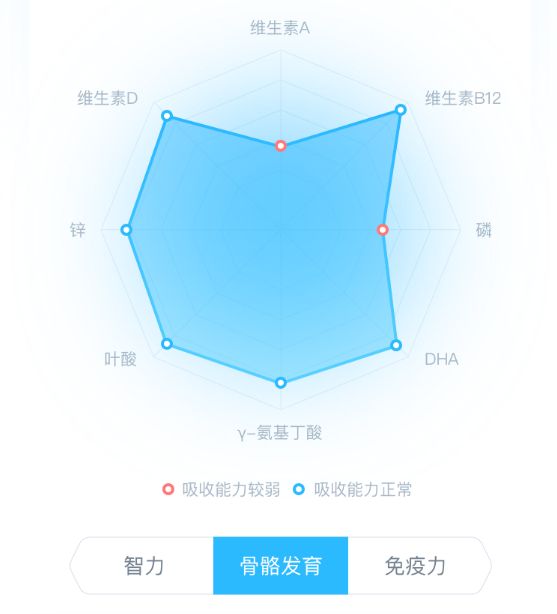自己把自己坑了
公司需求的时候,做了一种线形图,根据数值的大小,变换颜色。示例图如下:
线形图的写法:
color:function(params) {
let colorList = ['#2CBAFF','#FE7979'];
if (params.data < 70) {
return colorList[0];
} else if (params.data >= 70) {
return colorList[1];
}
}
产品经理问我,可以不可以做出这样的。设计图如下:
因为才使用这个插件一天,也不是很熟悉,感觉原理应该差不多。就答应了下来。
(自己挖坑 = =! )
等真正做的时候,发现事情并没有这么简单。。
-
首先,线图和雷达图的数据写法不一样
线图的数据如下:
series : [
{
type:'line', --类型 线
label: {
normal: { --文字样式
margin:2, --距离
show: true, --是否展示文字
position: 'top', --文字在点的哪个位置
fontSize:'14' --文字大小
}
},
-----------------------------数据在这---------------------------------
data:[86, 78, 65, 52, 51, 49],
-----------------------------数据在这---------------------------------
smooth: true, --让曲线变平滑的
symbolSize: 13, --圆点大小
color:function(params) { -- 颜色 颜色写在外面,就是圆点和文字同种颜色
let colorList = ['#2CBAFF','#FE7979'];
alert(params.data) 画重点!!! 循环输出 数据 86 78 65 52 51 49
if (params.data < 70) { /
return colorList[0];
} else if (params.data >= 70) {
return colorList[1];
}
},
lineStyle: { -- 线的样式
normal: {
color: '#2CBAFF',
width: 6,
shadowColor: 'rgba(0,70,139,0.9)',
shadowBlur: 50,
shadowOffsetY: 15
}
},
itemStyle:{ -- 圆点样式
borderWidth:3
},
}
]
线图的数据: data:[xxx,xxx,xxx,xxx,xxx,xxx,xxx]
雷达图数据如下:
series: [
{
type: 'radar',
radarIndex: 1,
data: [
{
-----------------------------数据在这---------------------------------
value: [100, 60, 50, 80, 50, 90, 80, 50, 80, 40], -- 数据
-----------------------------数据在这---------------------------------
symbolSize: 8, --拐点大小
lineStyle: { --线的样式
width: 4,
color: '#29B8FF'
},
areaStyle: { --数据圈内样式
normal: {
opacity: 0.9,
color: new echarts.graphic.RadialGradient(0.5, 0.5, 1, [
{
color: '#27B7FF',
offset: 0
},
{
color: '#5AD1FF',
offset: .4
}
])
}
}
}
],
itemStyle: { --圆点样式
normal: {
borderWidth: 0,
//color: '#2CBAFF',
color:function(params) { -- 颜色 颜色写在外面,就是圆点和文字同种颜色
let colorList = ['#2CBAFF','#FE7979'];
alert(params.data) 不同点 获取不到数据
if (params.data < 70) { /
return colorList[0];
}else if (params.data >= 70) {
return colorList[1];
}
}
}
},
}
雷达图的数据: data:[ value{xxx,xxx,xxx,xxx,xxx,xxx,xxx} ] 内
后来的做法:把itemStyle提了出去,与data同级
series: [
{
type: 'radar',
radarIndex: 1,
data: [
{ value: [75, 95, 90, 90, 85, 83, 80, 60, 90, 100],
symbolSize: 7,
// itemStyle: {
// normal: {
// borderWidth: 2,
// // color:'#2CBAFF'
// color:'red',
// // color: function (params) {
// // console.log(params);
// // let colorList = ['#2CBAFF', '#FE7979'];
// // alert(params.data[0].value)
// // if (params.data[0] < 70) {
// // return colorList[0];
// // } else if (params.data[0] >= 70) {
// // return colorList[1];
// // }
// // },
// }
// }, 删除
lineStyle: {
width: 4,
color: '#29B8FF'
},
areaStyle: {
normal: {
opacity: 0.9,
color: new echarts.graphic.RadialGradient(0.5, 0.5, 1, [
{
color: '#27B7FF',
offset: 0
},
{
color: '#5AD1FF',
offset: .4
}
])
}
}
}
],
itemStyle: { -- 放到这里
normal: {
borderWidth: 2,
color: function (params) {
let colorList = ['#2CBAFF', '#FE7979'];
for(let i = 0;i= 70) {
console.log(colorList[1])
}
}
}
}
}
}
]
这种写法会依次根据在控制台输出符合的颜色
-
第二,线图可以接受多个颜色,而雷达图radar只能接受一个颜色
我以为到这里已经结束了。
BUT。。。
当我把console.log换成return的时候。遍历数组,总是根据数组第一个值返回对应颜色,下面的不执行了,并把所有的拐点设置为第一个值符合的颜色。
简单来说,就是雷达图的颜色只接受一个参数。
换种思维
既然一组数据只能用一种颜色,我在绘制这个数组的时候,先做个遍历:
- 大于等于某值,生成一个数组,设置颜色1
- 小于某值,生成一个数组,设置颜色2
绘制
一个图表 设置三层覆盖
- 把所有数据绘制下来。不要圆点。只要线
- 把大于某数值的圆点绘制下来,设置蓝色
- 把小于某数值的圆点绘制下来,设置红色
#### 绘制了三个图表,有时间再详细解析。可以根据需要删除多余的。
预览地址


